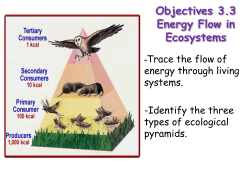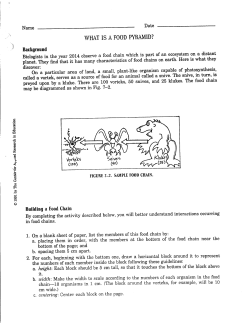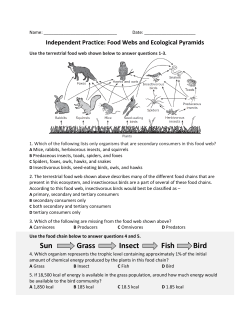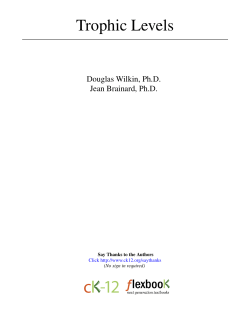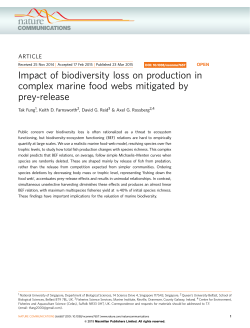
Lesson 5.3 Ecological Communities
CHAPTER 5 Evolution and Community Ecology Lesson 5.3 Ecological Communities https://www.youtube.com/watch?v=Gu2EzAIsVQU The sun provides the energy for almost all of the ecological communities and species interactions on Earth. Lesson 5.3 Ecological Communities Primary Producers (Autotrophs) • Capture energy from the sun or from chemicals and store it in the bonds of sugars, making it available to the rest of the community • Energy from the sun is captured by plants, algae, or bacteria through photosynthesis. • Energy from chemicals is captured by some bacteria through chemosynthesis. Did You Know? Deep-sea vents, far from sunlight, support entire communities of fish, clams, and other sea animals, which depend on energy converted through chemosynthesis. Lesson 5.3 Ecological Communities Consumers (Heterotrophs) •Rely on other organisms for energy and nutrients • Herbivores: plant-eaters • Carnivores: meat-eaters • Omnivores: combination-eaters ; plants and meat Detritivores and decomposers: recycle nutrients within the ecosystem by breaking down nonliving organic matter Producers and Consumers Are the Living Components of Ecosystems (2) • Decomposers • Consumers that release nutrients • Bacteria • Fungi • Detritivores • Feed on dead bodies of other organisms • Earthworms • Vultures Energy Flows Through Ecosystems in Food Chains and Food Webs • Food chain • Movement of energy and nutrients from one trophic level to the next • Photosynthesis → feeding → decomposition • Food web • Network of interconnected food chains A Food Chain Fig. 3-12, p. 63 A Food Web Fig. 3-13, p. 64 Lesson 5.3 Ecological Communities • An organism’s rank in a feeding hierarchy is its trophic level. • Primary producers always occupy the first trophic level of any community. Energy in Communities Pyramid of Energy 10% Rule • In general, only about 10% of the energy available at any trophic level is passed to the next; most of the rest is lost to the environment as heat. Or in hunting/gathering and in digestion/metabolism. Ecological efficiency: percentage of useable energy transferred as biomass from one trophic level to the next. Pyramid of Energy Flow Fig. 3-14, p. 65 • You practice…. Lesson 5.3 Ecological Communities Numbers and Biomass in Communities • A trophic level’s biomass is the mass of living tissue it contains. • In general, there are more organisms and greater biomass at lower trophic levels than at higher ones. Some Ecosystems Produce Plant Matter Faster Than Others Do • Gross primary productivity (GPP) • Rate at which an ecosystem’s producers convert solar energy to chemical energy and biomass • Kcal/m2/year • Net primary productivity (NPP) • Rate at which an ecosystem’s producers convert solar energy to chemical energy, minus the rate at which producers use energy for aerobic respiration • Ecosystems and life zones differ in their NPP Terrestrial Ecosystems Swamps and marshes Tropical rain forest Temperate forest Northern coniferous forest (taiga) Savanna Agricultural land Woodland and shrubland Temperate grassland Tundra (arctic and alpine) Desert scrub Extreme desert Aquatic Ecosystems Estuaries Lakes and streams Continental shelf Open ocean Fig. 3-15, p. 66 "All flesh is grass." • The planet’s NPP ultimately limits the number of consumers that can survive on earth. • Three hundred trout are needed to support one man for a year. The trout, in turn, must consume 90,000 frogs, that must consume 27 million grasshoppers that live off of 1,000 tons of grass. • G. Tyler Miller, Jr Humans use, waste or destroy approx 27% of the earth’s total NPP Up to 55% of the terrestrial NPP There are estimates that humans, their pets and livestock make up 98% of the earth’s total vertebrate biomass. Only 2% of the vertebrate biomass on earth belongs to wild species – thus, severly limiting our biodiversity on earth. Lesson 5.3 Ecological Communities Keystone Species • Species that have strong and/or wide-reaching effects on a community • Removal of a keystone species can significantly alter the structure of a community. • Pollinators • Top predators https://www.youtube.com/watch?v=TY6rzIYCDPk https://www.youtube.com/watch?v=_IWw8Ruz8Uo CASE STUDY – Sea Otter and Kelp Forests • Kelp forests: biologically diverse marine habitat • Major threats to kelp forests 1. Sea urchins 2. Pollution from water run-off 3. Global warming Core Case Study: Southern Sea Otters: Are They Back from the Brink of Extinction? https://www.youtube.com/watch?v=0UryWICizN4 • Habitat • Hunted: early 1900s • Partial recovery • Why care about sea otters? • Ethics • Tourism dollars • Keystone species Core Case Study: Southern Sea Otters: Are They Back from the Brink of Extinction? • They were over-hunted to the brink of extinction by the early 1900’s and are now making a comeback. • Hunted due to thick fur that keeps them warm and waterproof and due to competition for abalone and other shell fish. Figure 8-1 Core Case Study: Southern Sea Otters: Are They Back from the Brink of Extinction? • Sea otters are an important keystone species for sea urchins and other kelp-eating organisms. Figure 8-1 Case Study: Why Should We Care about the American Alligator? • Largest reptile in North America • 1930s: Hunters and poachers • Importance of gator holes and nesting mounds: a keystone species https://www.youtube.com/watch?v=KyJ4Sb_Cnbo • 1967: endangered species • 1977: comeback, threatened species American Alligator Fig. 4-18, p. 99 The Wolves of Yellowstone • https://www.youtube.com/watch?v=ysa5OBhXz-Q Foundation Species Help to Form the Bases of Ecosystems • Create or enhance their habitats, which benefit others • Elephants • Beavers • Prairie Dogs https://www.youtube.com/watch?v=kEh4r4iQiBU Foundation Species: Other Major Players Expansion of keystone species category. Foundation species can create and enhance habitats that can benefit other species in a community. Elephants push over, break, or uproot trees, creating forest openings promoting grass growth for other species to utilize. Beavers as “ecological engineers” Bat’s and birds in regeneration of destroyed forests by depositing seeds in their droppings.
© Copyright 2025
